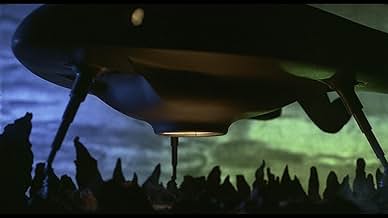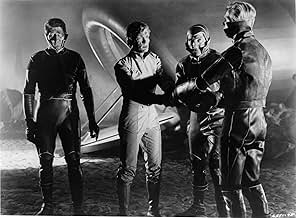NOTE IMDb
6,2/10
7,7 k
MA NOTE
Après avoir atterri sur une planète mystérieuse, une équipe d'astronautes commence à se retourner les uns contre les autres, à cause de l'influence incertaine de la planète et de ses étrange... Tout lireAprès avoir atterri sur une planète mystérieuse, une équipe d'astronautes commence à se retourner les uns contre les autres, à cause de l'influence incertaine de la planète et de ses étranges habitants.Après avoir atterri sur une planète mystérieuse, une équipe d'astronautes commence à se retourner les uns contre les autres, à cause de l'influence incertaine de la planète et de ses étranges habitants.
- Réalisation
- Scénario
- Casting principal
- Récompenses
- 1 nomination au total
Ángel Aranda
- Wess Wescant
- (as Angel Aranda)
Federico Boido
- Keir
- (as Rico Boido)
Vito Fasano
- Dead Galliott Crew Member
- (non crédité)
Giuseppe Mattei
- Brent
- (non crédité)
Avis à la une
In the film PLANET OF THE VAMPIRES, there is an undeniable creeping dread, a very real sense of terror, in every scene. Despite the obvious lack of money, Bava wrung some eerie, disturbing imagery out of his sf schlock piece. Considering this is an Italian production of the mid-60s, director Bava infuses some real originality into his story, taking a 1950s crew of square-jawed astronauts and forcing them to confront the future of horror: a horde of gore-streaked zombies, an omnipresent supernatural force invading the crew's minds, and a nihilistic ending.
What is great about POTV stems from Bava, his dynamic camera, and his framing. The marooned spacecraft atop a craggy hillside, approached by rescuing astronauts, looks like a haunted house against the black-clouded sky of the planet. When the living dead begin stalking the pitted, fiery surface of the planet, intent on killing the astronauts, Bava effectively uses the new horror icons of fear: not of fear, but of zombiefication, of characters who could be us, once just human, but now horribly returned as mutilated living corpses set to kill friends and family.
PLANET OF THE VAMPIRES is exciting, arresting in places, and nuanced in small ways even by the actors involved, all of them physically fit with numerous fight scenes. Sullivan and Bengall aren't creating their
characters, but they react realistically as human beings in an increasingly hopeless situation. The final scenes, of the
astronauts attempt to escape the planet, set upon by the living dead, have a psychological edge to go along with the action, as these noble travelers overcome their fear of the planet, of the zombies, and the horrible prospect of becoming zombies themselves, in order to end the hungering menace all around them. These scenes predate the best of George Romero's DEAD films or any John Carpenter flick, where a group of survivors are whittled down to just a few, and then to one, by a wave of seemingly unstoppable supernatural force.
It should be noted that "vampires" refer to parasites, not classic monsters, and truly this is more of a "zombie" film than a "vampire" movie. The film Bava made is gory and violent for 1965 when it was released, and as interesting as it was then, it's just as interesting now to see how POTV influenced later horror-film greats, not only in theory but in execution. And it's still better than 95 percent of the recent Hollywood sf-horror films of the past decade, bar none.
What is great about POTV stems from Bava, his dynamic camera, and his framing. The marooned spacecraft atop a craggy hillside, approached by rescuing astronauts, looks like a haunted house against the black-clouded sky of the planet. When the living dead begin stalking the pitted, fiery surface of the planet, intent on killing the astronauts, Bava effectively uses the new horror icons of fear: not of fear, but of zombiefication, of characters who could be us, once just human, but now horribly returned as mutilated living corpses set to kill friends and family.
PLANET OF THE VAMPIRES is exciting, arresting in places, and nuanced in small ways even by the actors involved, all of them physically fit with numerous fight scenes. Sullivan and Bengall aren't creating their
characters, but they react realistically as human beings in an increasingly hopeless situation. The final scenes, of the
astronauts attempt to escape the planet, set upon by the living dead, have a psychological edge to go along with the action, as these noble travelers overcome their fear of the planet, of the zombies, and the horrible prospect of becoming zombies themselves, in order to end the hungering menace all around them. These scenes predate the best of George Romero's DEAD films or any John Carpenter flick, where a group of survivors are whittled down to just a few, and then to one, by a wave of seemingly unstoppable supernatural force.
It should be noted that "vampires" refer to parasites, not classic monsters, and truly this is more of a "zombie" film than a "vampire" movie. The film Bava made is gory and violent for 1965 when it was released, and as interesting as it was then, it's just as interesting now to see how POTV influenced later horror-film greats, not only in theory but in execution. And it's still better than 95 percent of the recent Hollywood sf-horror films of the past decade, bar none.
Astronauts land on a mysterious planet and encounter many strange and dangerous things--like bodies that don't stay dead.
This Italian movie has horrendous dubbing (except for American Barry Sullivan), silly "special" effects and truly laughable, comic book level dialogue. But it's still worth seeing.
Director Mario Bava was a master at creating spooky atmospheres out of no budget. This was a VERY low budget film (it shows), but he covers it up with beautiful, inventive lighting, tons of dry ice and a really scary score. Also the astronauts wear tight leather outfits which are interesting and some of the Italian guys give good performances--Sullivan is horrible and the women are beyond belief. Also the film contains a few nice jolts and some very scary coming back from the dead sequences.
So, ignore the lousy dialogue and preposterous plot and concentrate on the visuals and sounds. Perfect late night viewing.
This Italian movie has horrendous dubbing (except for American Barry Sullivan), silly "special" effects and truly laughable, comic book level dialogue. But it's still worth seeing.
Director Mario Bava was a master at creating spooky atmospheres out of no budget. This was a VERY low budget film (it shows), but he covers it up with beautiful, inventive lighting, tons of dry ice and a really scary score. Also the astronauts wear tight leather outfits which are interesting and some of the Italian guys give good performances--Sullivan is horrible and the women are beyond belief. Also the film contains a few nice jolts and some very scary coming back from the dead sequences.
So, ignore the lousy dialogue and preposterous plot and concentrate on the visuals and sounds. Perfect late night viewing.
Mario Bava's Planet of the Vampires is one of the films credited as being a major influence on Ridley Scott's Alien (1979), and it's easy to see why: there are numerous scenes and elements that are very similar to those in Scott's movie (albeit with a distinct '60s Euro sci-fi flavour). Bava's movie isn't on a par with Alien in terms of overall quality-the movie suffers a little from its low budget and it treads water for a long while-but its sense of style and originality still makes it a lot of fun for those who enjoy retro sci-fi/horror.
The film starts as the crew of the spaceship Argos (a horseshoe shaped craft, much like the alien spaceship in Alien) approach the planet Aura having receiving a strange transmission (as in Alien). They land on the foggy surface of the planet (as in Alien) and are immediately gripped by a compulsion to attack each other. After this spate of craziness passes, the crew walk to their sister ship, the Galliot, which also landed on the planet, and find the crew dead. Further investigation of the surrounding area reveals the wreck of an alien ship (as in Alien) where they discover the giant skeletons of its extraterrestrial crew (as in Alien). Eventually, it transpires that the space signal intercepted by the Argos was sent by a dying race that seeks to inhabit any visitors unfortunate to land on their planet (parasitic creatures - Alien anyone?).
For all of their similarities, Bava's film couldn't be much more different to Alien in terms of style: whereas Scott's film aimed for a gritty sense of realism, Bava's is much more rooted in pulp sci-fi comics, with the strangely spacious spaceship Argus, its crew's snazzy uniforms (the collars and hoods are hilarious), lots of high tech equipment with flashing diodes, a bright colour palette, and strong use of light and shadow. The film also predates George Romero's Night of the Living Dead with the reanimated crew of the Galliot more akin to modern day zombies than vampires.
After quite a bit of filler, the surviving members of the Argus finally escape Aura, the film ending with a twist worthy of an episode of Rod Serling's The Twilight Zone.
6.5 out of 10, rounded up to 7 for the tasty female crew members of the Argus, sexy redhead Sanya (Norma Bengell) and blonde hottie Tiona (Evi Marandi).
The film starts as the crew of the spaceship Argos (a horseshoe shaped craft, much like the alien spaceship in Alien) approach the planet Aura having receiving a strange transmission (as in Alien). They land on the foggy surface of the planet (as in Alien) and are immediately gripped by a compulsion to attack each other. After this spate of craziness passes, the crew walk to their sister ship, the Galliot, which also landed on the planet, and find the crew dead. Further investigation of the surrounding area reveals the wreck of an alien ship (as in Alien) where they discover the giant skeletons of its extraterrestrial crew (as in Alien). Eventually, it transpires that the space signal intercepted by the Argos was sent by a dying race that seeks to inhabit any visitors unfortunate to land on their planet (parasitic creatures - Alien anyone?).
For all of their similarities, Bava's film couldn't be much more different to Alien in terms of style: whereas Scott's film aimed for a gritty sense of realism, Bava's is much more rooted in pulp sci-fi comics, with the strangely spacious spaceship Argus, its crew's snazzy uniforms (the collars and hoods are hilarious), lots of high tech equipment with flashing diodes, a bright colour palette, and strong use of light and shadow. The film also predates George Romero's Night of the Living Dead with the reanimated crew of the Galliot more akin to modern day zombies than vampires.
After quite a bit of filler, the surviving members of the Argus finally escape Aura, the film ending with a twist worthy of an episode of Rod Serling's The Twilight Zone.
6.5 out of 10, rounded up to 7 for the tasty female crew members of the Argus, sexy redhead Sanya (Norma Bengell) and blonde hottie Tiona (Evi Marandi).
I saw this film in it's 1965 American release, and at the time I was not overly impressed. It was obviously made on a low budget, the dialog dubbing is bad (although far superior to some other Italian imports I have seen), the acting alternates between wooden (Barry Sullivan) and outrageously overdone (i.e., "gravity effects", the reaction of the actor who smashes the "meteor deflector", numerous fear reaction shots of crew members). Time has proven that it has become a trend setter for numerous subsequent sci-fi films (most notably Ridley Scott's "Alien" (1979)). I recently viewed it again 37 years after it's release, and the similarities to "Alien" are unmistakable. The attentions of the crews of both films are attracted by mysterious radio signals originating from an unexplored world. The horseshoe shape of the ships in POTV resembles that of the wrecked alien spacecraft in "Alien". There are similar shots of the ship's landing gear in both films. Both crews find ancient wrecked spacecraft and skeletal remains of giant aliens on the planets they land upon. There is an unknown predatory alien presence in both films. Lots of gore footage exists in both films too, although POTV unarguably started this trend (alas, is there any recent sci-fi film that does not fall to this temptation?).I cannot believe that all these similarities are coincidental, and I suspect that Dan O'Bannon must have been heavily influenced by POTV, whether he realized it or not.
The use of lighting and color are also noteworthy. POTV still looks good today due to colorful exterior scenes (forgive the somewhat clumsy use of composite shots of the crew in a few scenes set against an obviously miniature landscape). Please also forgive the overzealous use of the zoom lens, which had just been developed at the time. One big demerit in set design comes from a scene inside the wrecked alien spacecraft. A prominently-featured prop appears to be the taillight lens from a 1957 Packard, complete with the backup light lens below it. It is positioned vertically in the shot, and perhaps the set designer was hoping that Italian audiences would not recognize it. Another detractor is the almost unlimited amount of area inside the ships. No ceilings are visible, and the various compartments look as big as football fields when compared to realistic spacecraft design criteria.
I found this to be an entertaining if somewhat flawed film, certainly more enjoyable than it was when I first watched it in 1965. It deserves a vote of 6/10.
The use of lighting and color are also noteworthy. POTV still looks good today due to colorful exterior scenes (forgive the somewhat clumsy use of composite shots of the crew in a few scenes set against an obviously miniature landscape). Please also forgive the overzealous use of the zoom lens, which had just been developed at the time. One big demerit in set design comes from a scene inside the wrecked alien spacecraft. A prominently-featured prop appears to be the taillight lens from a 1957 Packard, complete with the backup light lens below it. It is positioned vertically in the shot, and perhaps the set designer was hoping that Italian audiences would not recognize it. Another detractor is the almost unlimited amount of area inside the ships. No ceilings are visible, and the various compartments look as big as football fields when compared to realistic spacecraft design criteria.
I found this to be an entertaining if somewhat flawed film, certainly more enjoyable than it was when I first watched it in 1965. It deserves a vote of 6/10.
23 May 2008. Fourteen years after "The Planet of Vampires" (aka Demon Planet), Ridley Scott would create one of the most frightening and densely layered science fiction/horror films in history that he titled, "Alien." The strong suggestive set design and atmospheric elements from "The Planet of the Vampires" would re-appear in "Alien." Script plots from the original Star Trek television series that began its run in 1966, two years before, are nicely incorporated into this serious attempt at science fiction/horror. While obviously outdated by time, the eerie, alien sounds and visual designs are outstanding for its time. Overall, this movie stands the test of time for its power, its emotional, visceral impact on the senses and its delivery. Eight out of Ten Stars.
Le saviez-vous
- AnecdotesThis film marks the first collaboration between Mario Bava and his son/assistant director Lamberto Bava. Lamberto would later become a director himself.
- GaffesWhen Toby and Mark duke it out, Toby bumps into and moves the flight seat revealing it to be unattached to the deck.
- Citations
Capt. Mark Markary: I'll tell you this, if there 'are' any intelligent creatures on this planet... they're our enemies.
- Versions alternativesThe original Italian version runs 88 minutes long. The US version runs 86 minutes long.
- ConnexionsFeatured in Aweful Movies with Deadly Earnest: The Demon Planet (1969)
Meilleurs choix
Connectez-vous pour évaluer et suivre la liste de favoris afin de recevoir des recommandations personnalisées
Détails
- Date de sortie
- Pays d’origine
- Langues
- Aussi connu sous le nom de
- El planeta de los vampiros
- Lieux de tournage
- Sociétés de production
- Voir plus de crédits d'entreprise sur IMDbPro
Box-office
- Budget
- 200 000 $US (estimé)
- Durée1 heure 28 minutes
- Mixage
- Rapport de forme
- 1.66 : 1
Contribuer à cette page
Suggérer une modification ou ajouter du contenu manquant

Lacune principale
What is the Brazilian Portuguese language plot outline for La Planète des vampires (1965)?
Répondre



























